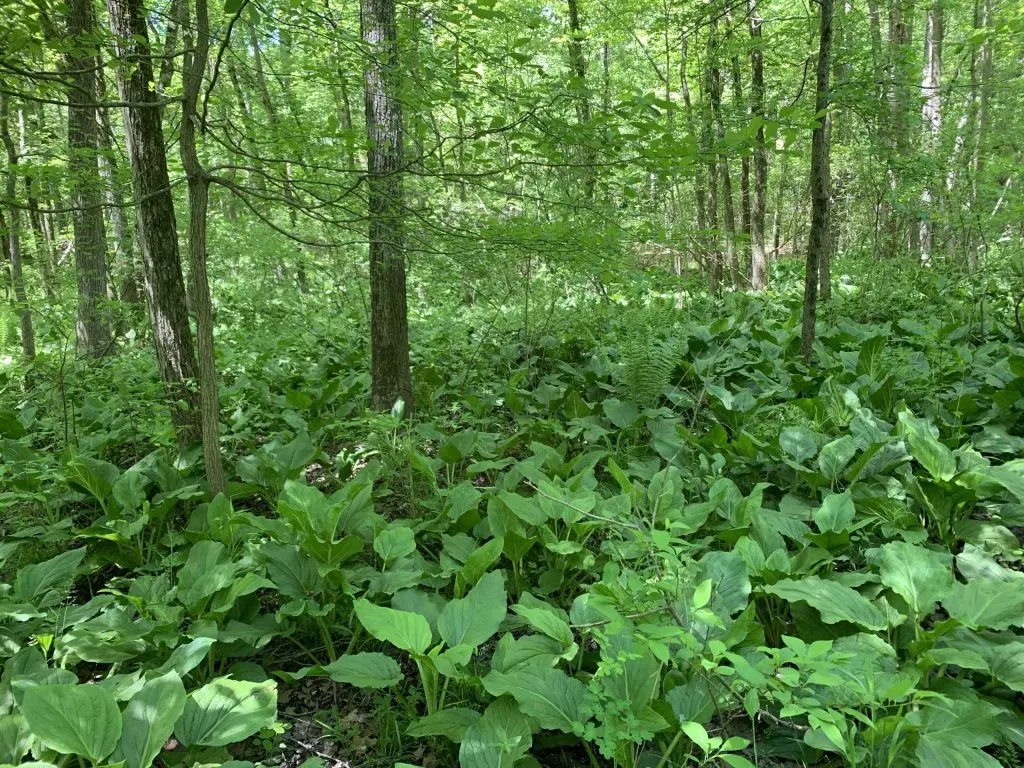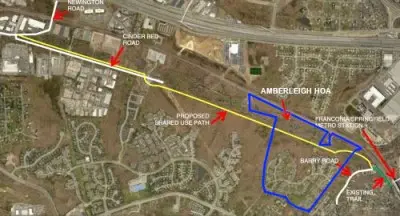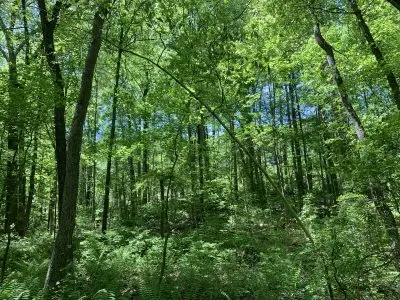Page updated: Saturday, May 4, 2024 @ 11:30am

Newington Conservation Site stream valley with wetlands, filled with skunk cabbage. Photo courtesy Friends of Accotink Creek
The big picture
Given the worsening climate crisis, we must take every action we can to reduce carbon emissions, capture carbon emissions, and plan development in urban areas with an eye toward both climate resiliency and sustainability. At Nature Forward (formerly Audubon Naturalist Society), those approaches, along with values including equity, guide our conservation priorities and advocacy work.
That’s why a project proposal like the Cinder Bed Road Bikeway in Fairfax County’s Franconia (previously Lee) District is so complex. This proposal would construct a ten-foot wide paved trail connecting to the Franconia-Springfield Metro through the Newington Conservation Site. While the southern parts of the trail exist in some capacity and are already paved, the northern section (known as “Segment 6“), primarily through the Amberleigh HOA’s property, is not yet built. Plans call for the entire trail to be lit at night, which can impact wetland fauna. At risk is a stream and wetlands area containing habitats classified as “vulnerable” as well as animals classified as “threatened” at both the state and federal levels.

Cinder Bed Road Bikeway trail proposed route bisecting the Newington Conservation Site. Amberleigh HOA property, where a paved trail does not exist today, is shown outlined in blue.
We need safe, connected active transportation networks
Nature Forward supports adding bikeways and active transportation networks. Transforming the DMV region into a more bikeable, walkable metro area by offering non-car alternatives to residents is a critical piece of the puzzle of reducing carbon emissions. Safe trails offer ideal transportation support when they are part of a complete network that connects people to transit centers.
We need to preserve sensitive habitats
At the same time, however, preserving globally rare habitats and wetlands in our urbanizing areas is important for biodiversity and resilience. If fact, the draft Resilient Fairfax plan clearly states: “Adaptive Environments improve the county’s overall resilience to climate impacts by supporting ecosystems’ ability to naturally mitigate risks and provide ecosystem services. When ecosystems are healthy and protected, they are better able to provide critical services that support county-wide resilience. For example, wetlands, thriving stream valley parks, and green infrastructure are able to naturally absorb excess flood waters.”
Our environmental review
In order to better understand the environmental impacts and implications of this trail proposal, Nature Forward partnered with the Audubon Society of Northern Virginia, Friends of Accotink Creek, Sierra Club Great Falls Group, and Virginia Native Plant Society Potowmack Chapter.
Based on our collective analysis, the current Active Transportation planning process is fundamentally flawed. That process has led the county to select this costly and environmentally destructive route for the Cinder Bed Road Bikeway. It has also caused divisive and unnecessary conflict between supporters of active transportation and nature protection advocates late in the design process.

Habitat found along the proposed route of Cinder Bed Road Bikeway: Sweetbay Magnolia, a rare wetland tree species, with its characteristic leaning slender trunk. Photo courtesy of Friends of Accotink Creek
In proposing this trail be located in a healthy stream and wetlands habitat, Fairfax County avoided an Environmental Assessment and skipped over an alternatives analysis. Additionally, the county initially conducted only a cursory exploration for a federally-threatened orchid (the Small Whorled Pogonia) during a season when it would be impossible to find. It’s like looking for a Valentine’s Day card in July. At our urging, a second survey was done during the proper season, however, none were located.
Also at our urging, in 2023, Virginia’s Department of Conservation and Recreation confirmed the vulnerable habitat in the area of the proposed trail was twice as large as originally specified. This new information confirms our concerns.
Our joint letters of environmental concern
Our organizations expressed the above environmental concerns in writing (read our March 2022 letter) to Supervisor Lusk and the full Board of Supervisors, Fairfax County Department of Transportation, and the US Army Corps of Engineers.
In July 2022, our organizations and also Faith Alliance for Climate Solutions wrote a letter to Supervisor Lusk and other decision makers (read our July 2022 letter) outlining our opposition to Segment 6, the significant amount of cycling infrastructure that exists today, and the need to maintain what we have for both cycling infrastructure and natural resources.
Our organizations have continued discussions with Supervisor Lusk and staff and we look forward to a meeting in the summer of 2024 to learn more the status of this segment of the project.
We oppose a Cinder Bed Road Bikeway proposal that bisects this special area
After considerable discussions with staff and our partners, Nature Forward opposes the proposed trail alignment bisecting the Newington Conservation Site (“Segment 6“). This is not a position that we take lightly or have come to easily. The location of active transportation trails must avoid our most valuable natural resources, Unfortunately, this one does not.
Alternatives exist today
Alternative routes following existing paved paths and roads already exist which more directly connect residents and commuters to the metro .
The existing paved paths and routes connecting Cinder Bed Road to Morning View Lane to Crestleigh to Barry Road to the metro are very safe, have curb cuts for bikes where needed, and are well-maintained, though additional signage could improve navigation.
For current routes along roads, however, further investments by the Virginia Department of Transportation (VDOT) would need to be made to connect to metro more comfortably and safely. We ask that VDOT ensure we have maintenance of existing active transportation infrastructure (Loisdale Road) and protected bike lanes or separate cycle tracks (Beulah Street).
Contact your elected officials
We also encourage you to speak up. Urge Franconia District Supervisor Lusk and Supervisor Alcorn (Chair of the Board’s Transportation Committee) to evaluate alternative ways to connect communities to the Franconia-Springfield Metro without while preserving and not disturbing one of our last rare seepage swamp habitats. You may do so via the form below.
